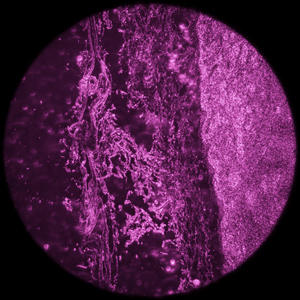

Blocking the spliceosome could inhibit the growth of MYC-driven tumors.
© defun/iStock/Thinkstock
A widespread cancer-causing protein called MYC promotes the growth of tumor cells in part by ensuring that RNA transcripts are properly spliced, according to latest work from A*STAR researchers1. Drugs that block parts of the cell’s splicing machinery may provide a new way to halt the proliferation of MYC-driven cancers.
“Cells overexpressing the oncogene MYC will be more sensitive to inhibition of the splicing machinery,” says Ernesto Guccione, from the A*STAR Institute of Molecular and Cell Biology, who led the research. “Targeting the core components of the splicing machinery may be a novel Achilles’ heel to therapeutically target MYC-driven tumors.”
The MYC oncoprotein is a central driver in the majority of human cancers. MYC binds to active regulatory elements in the genome and broadly amplifies gene expression, leading to rampant cell growth. This process, however, is not random or indiscriminate. Guccione, in collaboration with colleagues in Italy, recently showed that MYC preferentially activates distinct subsets of target genes to control cellular states2.
Following up on that observation, Guccione and his colleagues from A*STAR decided to investigate which gene sets are turned on by MYC in mouse models of lymphoma. One gene set that stood out involved components of the spliceosome, the molecular complex that helps prepare messenger RNA (mRNA) transcripts for protein production by removing noncoding segments called introns.
These genes include PRMT5, which codes for a key enzyme that ensures proper maturation of the spliceosomal complex. PRMT5 and others help assemble the proteins that form the spliceosome. Guccione’s team showed that mice with only one functional copy of PRMT5 — instead of the usual two — develop lymphoma more slowly.
PRMT5 depletion led to a range of splicing defects linked to the retarded tumor growth. And drug-like molecules called antisense oligonucleotides (which disrupt proper splicing) also reduced the viability of cancer cells taken from mice with lymphoma. Together, the results suggest that splicing-associated genes like PRMT5 are critical to MYC-driven tumor formation.
Further support for this idea came from human clinical samples. Guccione and colleagues studied samples from people with lymphoma. They found a link between MYC overexpression and the activity of spliceosome-related genes. Notably, high expression of PRMT5 correlated with worse clinical outcomes. In the laboratory, knocking out PRMT5, or another core component of the splicing machinery in human lymphoma cells lines, also reduced cell viability.
“The inhibition of PRMT5 may have potential therapeutic utility in cancer treatment,” explains Cheryl Koh, a postdoctoral fellow in Guccione’s lab and the co-first author of the new study.
The A*STAR-affiliated researchers contributing to this research are from the Institute of Molecular and Cell Biology, the Institute of High Performance Computing and the Bioinformatics Institute.
References
Koh, C. M., Bezzi, M., Low, D. H. P., Ang, W. X., Teo, S. X. et al. MYC regulates the core Pre-mRNA splicing machinery as an essential step in lymphomagenesis. Nature advance online publication, 11 May 2015 (doi: 10.1038/nature14351). | article
Sabò, A., Kress, T. R., Pelizzola, M., de Pretis, S., Gorski, M. M. et al. Selective transcriptional regulation by Myc in cellular growth control and lymphomagenesis. Nature 511, 488–492 (2014). | article












